Accepted Scientific Name: Delosperma echinatum (Lamarck) Schwantes
Möller's deutsche gärtner-zeitung 42: 258 1927 Möller

Trichodiadema echinatum (Delosperma echinatum) Photo by: © Plantemania
Origin and Habitat: Eastern Cape, South Africa.
Altitude: 150 - 860 metres above sea level.
Synonyms:
See all synonyms of Delosperma echinatum
back
Accepted name in llifle Database:Delosperma echinatum (Lamarck) SchwantesMöller's deutsche gärtner-zeitung 42: 258 1927Synonymy: 6
back
Common Names include:
ENGLISH: Pickle plant
CHINESE (中文): 雷童
RUSSIAN (Русский): Делосперма ежевидная, Делосперма колючая
Description: Delosperma echinatumSN|26454]]SN|26454]], also known as the Pickle plant, is a type of ice plant, native to South Africa. It has odd looking succulent leaves with bristly hairs on small, thin wiry spiny stalks. Leaves themselves are also spiny (but not dangerously so). The most notable features are the water vesicles that cover the leaves.
Habit: It is a small perennial succulent shrub which has a more upright habit than most Delospermas, often reaching 45 cm in height when grown outdoors (usually less than 30 cm tall when grown in containers or baskets).
Roots: It has deep succulent roots.
Leaves: Up to 2,5 cm long, light green covered by water vesicles.
Flowers: Small white, pale greenish-yellow or yellow, up to 2 cm in diameter at the tips of stems.
Blooming Time: Spring.
Bibliography: Major references and further lectures
1) Heidrun E.K. Hartmann “Illustrated Handbook of Succulent Plants: Aizoaceae A-E” Springer, 2002
2) Burgoyne, P.M. 2006. Delosperma echinatum (Lam.) Schwantes. National Assessment: “Red List of South African Plants” version 2013.1. Accessed on 2014/04/06
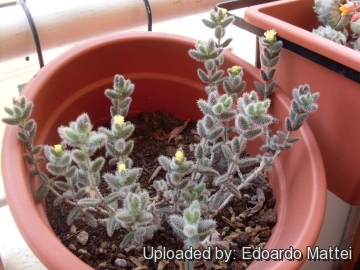 Trichodiadema echinatum (Delosperma echinatum) Photo by: Edoardo Mattei
Trichodiadema echinatum (Delosperma echinatum) Photo by: Edoardo Mattei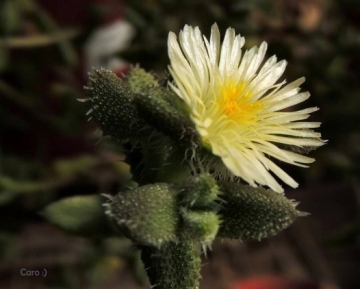 Trichodiadema echinatum (Delosperma echinatum) Photo by: Carolina González
Trichodiadema echinatum (Delosperma echinatum) Photo by: Carolina González Trichodiadema echinatum (Delosperma echinatum) Photo by: Edoardo Mattei
Trichodiadema echinatum (Delosperma echinatum) Photo by: Edoardo Mattei Trichodiadema echinatum (Delosperma echinatum) Photo by: Giuseppe Distefano
Trichodiadema echinatum (Delosperma echinatum) Photo by: Giuseppe Distefano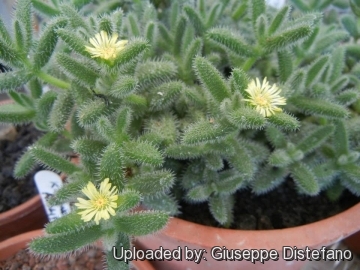 Trichodiadema echinatum (Delosperma echinatum) Photo by: Giuseppe Distefano
Trichodiadema echinatum (Delosperma echinatum) Photo by: Giuseppe Distefano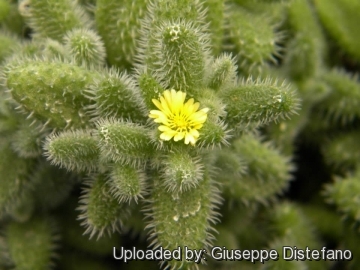 Trichodiadema echinatum (Delosperma echinatum) Photo by: Giuseppe Distefano
Trichodiadema echinatum (Delosperma echinatum) Photo by: Giuseppe Distefano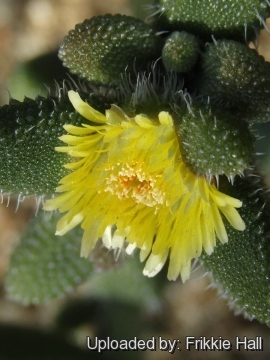 Trichodiadema echinatum (Delosperma echinatum) Photo by: Frikkie Hall
Trichodiadema echinatum (Delosperma echinatum) Photo by: Frikkie Hall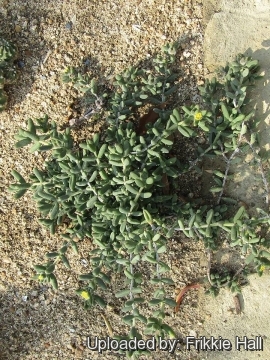 Trichodiadema echinatum (Delosperma echinatum) Photo by: Frikkie Hall
Trichodiadema echinatum (Delosperma echinatum) Photo by: Frikkie HallCultivation and Propagation: Delosperma echinatumSN|26454]]SN|26454]] is one of the more easily cultivated succulent species. It is also surprisingly hardy outdoors. It's tolerant of wet and cold and can tolerate less than perfect drainage, but it will suffer under prolonged water stagnation, and thus prefers well drained soils, or even rocky terrain. Excellent potted plant.
Growth rate: It grows fast, needs to be contained or it becomes invasive, and also like to self seed everywhere. If not checked it could take over entire areas of garden, and even escape into the wild.
Soil: It prefers deep, well-drained, lean, sandy, or rocky soils. The soil mixture should be slightly acidic, with a pH of 6.5 to 6.0.
Fertilization: They should be fertilized only once during this period with a very dilute fertilizer. We usually dilute the fertilizer to ¼ the recommended rate.
Watering: Water moderately from early spring to the end of autumn (plants should be allowed to dry in-between waterings), and keep the compost quite dry when the plants are dormant watering, only if the plant starts shrivelling (, but they will generally grow even in winter if given water). Disliking overly wet conditions, it is best to also cover it with an anchored sheet of plastic during the winter if climate is particularly wet and cold. During wet seasons allow air circulation.
Exposure: It need full sun to light shade. In full sun it is more compact than in shade.
Hardiness: It is tolerant of both heat and cold and is hardy from zones 7 through 10. In areas prone to very intense frosts, grow in an intermediate greenhouse or conservatory, in pots of cactus compost, obtainable from good garden centres. When grown outside in zone 7, it should be treated as an annual.
Propagation: Delosperma echinatumSN|26454]]SN|26454]] is easily propagated from stem cutting or by seed. Seed readily germinate at 12 to 18° C.
Your Photos

by Frikkie Hall

by Carolina González

by Edoardo Mattei

by Edoardo Mattei

by Giuseppe Distefano
























